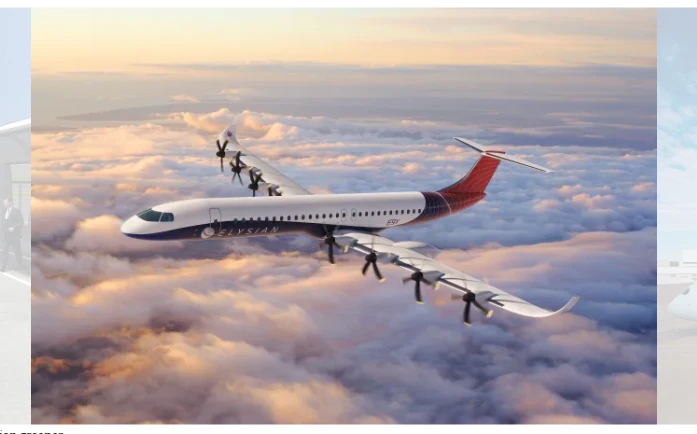Fully electric plane can fly 500 miles with 90 passengers on board

Stay tuned with 24 News HD Android App

Commercial aviation is struggling to reduce its climate impact and it’s currently not on track to meet its goal of net-zero emissions by 2050. Sustainable aviation fuel is not being produced fast enough and there seem to be few alternatives on the horizon to fuel-hungry jet engines and turboprops.
One problem is that electrification is not as easy with planes as it is with road vehicles, and the consensus in the industry seems to be that battery technology needs to evolve before electric passenger aircraft can become a reality.
However, Dutch startup Elysian is challenging that assumption with its plans for a fully electric regional aircraft, with a range of 500 miles (805 kilometres) and space for 90 passengers, capable of reducing emissions by 90% — which it aims to fly commercially within a decade.
“Many experts say you need battery technology beyond [anything that will be available until] 2050 to get reasonable range and payload capability,” says Reynard de Vries, director of design and engineering at Elysian. “But the question we asked ourselves was, ‘how do I get the maximum range for the battery technology that we already have?’ One can fly much farther with battery-powered electric aircraft than what most studies claim — if you make the right choices.”
The plane, called E9X, exists only on paper for now — Elysian plans to build a scale model within two to three years, and a full-scale prototype by 2030. However, its main design features are already known, and are somewhat surprising. “You shouldn’t assume that an electric plane is going to look like the (most successful) planes of today,” de Vries says, adding that a common misconception is that electric planes should essentially be electrified versions of the lightest regional turboprops.
That, he says, would make the range too limited, likely below 60 miles. “What you really have to do is design it from scratch, starting with a blank sheet. What you end up with is a plane that in weight proportions, for example, looks much more like old 1960s jets. A plane with a very high proportion of batteries and a much lower proportion of structural weight. The result is an aircraft that’s much larger and heavier, but can fly much farther than people previously thought.”
The E9X will have eight propeller engines and a wingspan of almost 138 feet (42 meters) — larger than a Boeing 737 or an Airbus A320, though both can carry more than double the passengers — as well as a thinner fuselage, which de Vries says improves both the structural and aerodynamic characteristics.
This design is the result of a collaboration with the Delft University of Technology, the oldest and largest technical university in the Netherlands, and its principles are explained in a scientific paper titled “A new perspective on battery-electric aviation”, which has de Vries and Rob Wolleswinkel, Elysian’s co-founder, among its authors.
One key tenet is that the batteries will be placed in the wings rather than the fuselage. “That’s a critical design choice,” says de Vries. “Batteries represent a significant chunk of the weight of the plane, and what you want to do with weight is put it where the lift is being generated.”
The battery technology will be similar to what’s available today, plus whatever advancements will be made in the next four or five years, rather than a radical step up, according to de Vries. “That opens up different scenarios,” he adds. “The most conservative one puts the useful range at 300 miles (482 kilometres), but we believe that a more realistic target, four years from now, is 500 miles.”
Among the other known design elements is the placement of the landing gear in the wings rather than the body of the plane, wingtips that can fold up to save space and a gas-turbine-based “reserve energy system” that can provide emergency power in case of a diversion.
All together, de Vries expects the aircraft’s climate impact to be between 75% and 90% lower than today’s narrowbody jets, even when accounting for the production of the batteries and the electricity used to recharge them.
The E9X will be designed to fit within current airport infrastructure, without the need for any adjustment or upgrade. The turnaround time, however, might be a challenge due to the need to charge the batteries, which takes more time than filling up the tank with fuel. “Our target right now is a maximum charging time of 45 minutes, which would imply a slightly longer turnaround time than what some airlines are used to, especially the low-cost operators. But that’s the upper limit — the average time will be around half an hour.”
There are ongoing discussions with airlines around the world, he adds, and the plane will likely attract the interest of regional and commuter airlines. According to de Vries, it could also benefit secondary airfields that are currently underserved because of noise or emissions limitations, or because it’s not economical for airlines to serve them.
Finally, from a passenger perspective, he believes the E9X will offer a quieter, more enjoyable flight experience, and he aims to solve one of the most pressing issues with today’s travel: the scarcity of cabin luggage space.–CNN
